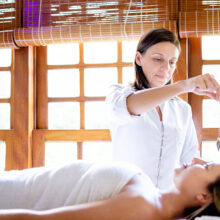Prenatal Massage: What to Expect When You’re Expecting Relaxation
- Published: Wednesday, December 11th 2019
- in Spa
Expecting mothers will likely all agree, carrying that little bundle of joy isn’t always so joyful. Back pain, discomfort, and fatigue are all associated with pregnancy and a great way to alleviate these discomforts is with a trip to the spa. While many spa treatments are safe for expecting mothers, including manicures, pedicures, and facials, perhaps the most beneficial and relaxing is prenatal massage.
What is a prenatal massage?
A prenatal massage is much like a regular massage, but the therapist will be careful to avoid putting pressure on certain areas and will use unique positions to keep the mother comfortable and safe. For example, rather than spending the entire session lying face-down, you will be on your side or in a semi-reclined position. This avoids putting pressure on your abdomen and disrupting blood flow.
During a prenatal massage, the therapist will avoid using deep pressure on your abdomen and legs. Gentle pressure may be used, but deep pressure on your legs can cause problems if you have blood clots.
What are the benefits?
Prenatal massage has many benefits. Here are a few.
- Can relieve back pain
- Improves sleep and mood
- Decreases stress
- Reduces labor complications
Prenatal massage is best given while you lie on your side propped up by pillows. Neck and shoulder massage is a safe sitting-up option, as well. Before booking your massage be sure to check that your therapist has extensive experience practicing massage on pregnant women and contact your doctor before your treatment to make sure she signs off on your trip to the spa.
Keep your day at the spa as carefree as it should be and make a mental note of these tips:
- Request a massage therapist who has been specifically trained in prenatal treatments. A qualified therapist will have completed a maternity course that teaches basics such as positioning and pressure points for pregnancy. We want to make sure you enjoy this treat.
- Look for spas that offer special pregnancy services. Qualifications matter, after all.
- Listen to your body and let the therapist know if you’re uncomfortable. Now is the time to express yourself, develop trust with your therapist and make sure you enjoy this experience. Some spas use tables with cutouts to accommodate a pregnant belly, but prenatal support pillows are also available. These are easy to adjust and generally more comfortable. If you aren’t comfortable for any reason, just ask to switch positions or alter the treatment. Also, bathroom breaks are important so let the therapist know you need a moment.
- Drink water throughout and after your spa visit.
Things to Avoid:
- Avoid contrast hydrotherapy (alternating hot and cold pools or rooms). Constant temperatures are best.
- Skip hot baths, steam rooms, and saunas (traditional and infrared). Heat and sweat cause decreased blood flow (and blood to pool in your feet), which means the baby gets less oxygen, says Joel Evans, M.D., author of The Whole Pregnancy Handbook.
- Say no to body wraps, which cause perspiration and raise the core body temperature.
- Detoxifying body scrubs are a don’t. It’s possible that scrubs release toxins into the bloodstream, not a good idea when a very tiny person is sharing it! Instead: Try light body buffs for itchy and dry skin.
- Just remember Essential oils (concentrated plant extracts) are off-limits during the first trimester, according to Dr. Evans. It’s safe to reintroduce rose, lavender, and chamomile during the second trimester, as long as they’re diluted with twice the amount of carrier oil, but peppermint, rosemary, sage, and jasmine shouldn’t be used at all, Dr. Evans explains, because they can trigger uterine contractions. Some scents can also trigger nausea, so many spas offer scent-free products.
- If you’re high-risk, check with your doctor before booking.



